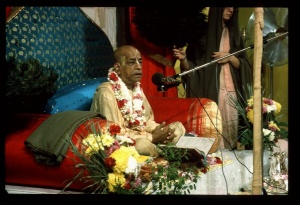SB 3.1.23

A.C. Bhaktivedanta Swami Prabhupada
TEXT 23
- anyāni ceha dvija-deva-devaiḥ
- kṛtāni nānāyatanāni viṣṇoḥ
- pratyaṅga-mukhyāṅkita-mandirāṇi
- yad-darśanāt kṛṣṇam anusmaranti
SYNONYMS
anyāni—others; ca—also; iha—here; dvija-deva—by the great sages; devaiḥ—and the demigods; kṛtāni—established by; nānā—various; āyatanāni—various forms; viṣṇoḥ—of the Supreme Personality of Godhead; prati—each and every; aṅga—part; mukhya—the chief; aṅkita—marked; mandirāṇi—temple s; yat—which; darśanāt—by seeing from a distance; kṛṣṇam—the original Personality of Godhead; anusmaranti—constantly remembers.
TRANSLATION
There were also many other temples of various forms of the Supreme Personality of Godhead Viṣṇu, established by great sages and demigods. These temples were marked with the chief emblems of the Lord, and they reminded one always of the original Personality of Godhead, Lord Kṛṣṇa.
PURPORT
Human society is divided into four social orders of life and four spiritual divisions, applying to each and every individual person. This system is called varṇāśrama-dharma and has already been discussed in many places in this great literature. The sages, or persons who completely devoted themselves to the spiritual upliftment of the entire human society, were known as dvija-deva, the best amongst the twice-born. The denizens of superior planets, from the moon planet and upwards, were known as devas. Both the dvija-devas and the devas always establish temples of Lord Viṣṇu in His various forms, such as Govinda, Madhusūdana, Nṛsiṁha, Mādhava, Keśava, Nārāyaṇa, Padmanābha, Pārtha-sārathi and many others. The Lord expands Himself in innumerable forms, but all of them are nondifferent from one another. Lord Viṣṇu has four hands, and each hand holds a particular item—either a conchshell, wheel, club or lotus flower. Of these four emblems, the cakra, or wheel, is the chief. Lord Kṛṣṇa, being the original Viṣṇu form, has only one emblem, namely the wheel, and therefore He is sometimes called the Cakrī. The Lord's cakra is the symbol of the power by which the Lord controls the whole manifestation. The tops of Viṣṇu temples are marked with the symbol of the wheel so that people may have the chance to see the symbol from a very long distance and at once remember Lord Kṛṣṇa. The purpose of building very high temples is to give people a chance to see them from a distant place. This system is carried on in India whenever a new temple is constructed, and it appears that it is coming down from a time before recorded history. The foolish propaganda by atheists that temples were constructed only in later days is refuted here because Vidura visited these temples at least five thousand years ago, and the temples of Viṣṇu were in existence long, long before Vidura visited them. The great sages and demigods never established statues of men or demigods, but they established temples of Viṣṇu for the benefit of common men, to raise them to the platform of God consciousness.